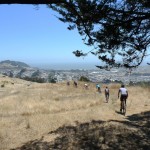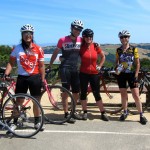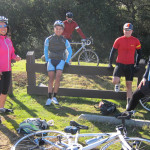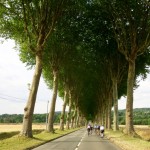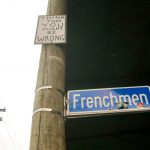Much planning went into the two-week trip to Japan that Eric and I took last spring (which feels like an eternity ago now). I dug into quite a bit of research via deep dives into websites, interviewed friends and pored over their past itineraries; downloaded many apps for train timetables and language lessons, which included some enthusiastic yet short-lived attempts to learn travel-friendly Japanese; and plotted out an elaborate schedule as we were going to traverse the country mostly by bicycle. (Which would be a first for me, since my last trip back in 2005 was mostly by train.)
The pros of visiting Japan: Everyone we encountered was so helpful: there were a few times when our Google Translate app would fail us, and folks would go out of their way to assist us clueless tourists. One afternoon, we couldn’t figure out where to park our bikes in a busy shopping district, but these kind gentlemen walked us around and around the neighborhood trying to find a lot with space for us; or whenever we’d get confused in a train station, there was always an accommodating conductor ready to offer up directions; another time when we couldn’t read a menu, other customers in the restaurant helped us place our dinner order; or when we almost missed our connecting flight and the flight attendant located us in the terminal and sprinted with us to the gate so that we wouldn’t miss it — and didn’t even act upset that we were being so flaky because we were distracted by shopping for souvenirs.) I deeply appreciated the warmth and generosity we encountered everyday during this trip (and my previous one), regardless of whether we were in the big cities or the smaller towns out in the countryside.
And the food was just as delicious as I remembered it — from tiny, hole-in-the-wall ramen joints and train station kiosks to more upscale establishments. One of the best meals we had was from Denny’s (shocking, I know), and we practically lived off of konbini onigiri. (Here’s our power ranking of these cheap, tasty rice snacks for your reference: 7-11; Family Mart; Lawson Station; Mini Stop.)

I’m also enamored of traditional Japanese architecture and design — and share their love for cute cartoon characters, too, which you see everywhere from public service announcements, advertisements to town mascots.
The cons were few; if I could have any wish granted, it would be that I’d have the ability to speak and understand any language. I know I’m missing so much of the nuances of a culture by mainly conversing through gestures, apps or broken phrases. So that’s one regret I have — that I didn’t make more of an effort to learn more Japanese ahead of time. The only other aspect of our trip that could be frustrating was traveling by train with our bikes since you have to rinko them (more on that below.) It takes a lot more perseverance and strength — and I was burned out by the end of our trip. But hopefully it’ll just make my next journey go much more smoothly with all of the knowledge I’ve acquired … and I do plan on going back!
Planes, Trains and Automobiles
If you plan on traveling with your bike on trains, be sure to pack a ton of patience with you, too. We train-hopped often throughout our trip; the moment we landed in Japan, we took a combination of shinkansen, local trains and a taxi from Narita Airport to reach the the suburbs of Tokyo where Eric’s cousin lived. This can be tough a mental (and physical) challenge since you have to rinko your bicycle, which means you have to take it partially apart, then put it in an enclosed bag. The cars can be really crowded, so there’s not really any extra space for two full-sized bikes — even when they’re disassembled. So once you’ve managed to sequester it away (no easy feat in itself as it took us close to an hour the first time), it gets even more complicated: you’re also trying to navigate the byzantine rail system and not get lost or miss transfers; staring at several apps on your phone while rushing as fast as you can so you don’t miss the punctual trains; and hauling a bunch of extra weight, too. On the longest leg of our trip by train, I decided to just stand in the family car near the bathroom for several hours rather than try and squeeze my bag behind a cramped seat. (We vowed to bring folding bikes next time.)
Our first adventure traveling rinko-style was to the Yamanashi Prefecture, located due west of Tokyo. We took a train from the city so we could ride to Lake Yamanakako, which was a lovely 14-mile / 2500~ ft. ride from the station and where we spent the night. The next day, we pedaled 17 miles to Lake Shoji for the weekend. Eric’s cousin’s in-laws own and operate a quaint ryokan, or a traditional Japanese inn, right alongside its enchanting shoreline. We spent our days biking on dirt trails and our evenings eating sumptuous omakase meals and soaking in their onsen (hot baths). Breathtaking views of Mt. Fuji greeted us at every turn, especially when the waters of the lake were calm and reflective, producing “Mirror Fuji”.
After our relaxing time there, we headed southward for a leisurely 38-mile ride past Lakes Tanuki and Motosu, complemented by views of picturesque rice paddies in the countryside, an onigiri lunch stop on the outskirts of a cemetery and a brief tour of the Fujisan Hongū Sengen Taisha and Fuji World Heritage Center. Then we barely rinkoed our bikes in time to catch the shinkansen in Fuji City to Imabari.
click images to enlarge
All of the images have failed to load.
This is most likely a TimThumb permissions error.
Go to the Justified Image Grid settings, TimThumb & CDN tab. Click check permissions then click 0755 or 0777 to see if that works (or do it manually on the files and folders it lists there in case chmod fails).
Also read the troubleshooting guide in the documentation on what else to do.
Tip: Install the official WP plugin 'Jetpack' by Automattic and enable 'Photon'. Jetpack enables you to connect your blog to a WordPress.com account to use the powerful features normally only available to WordPress.com users. It's an excellent TimThumb alternative and will make your images load faster. Note that you won't be able to use special effects due to cross-domain security limitations. It'll also make Justified Image Grid high resolution display or Retina ready by devicepx.js! Read more at: jetpack.me
Another possibility is that you are using W3 Total Cache to minify JS - turn that feature off.
Six Bridges of the Shimanami Kaido
When I first heard about the Shimanami Kaido, it sounded like a dream route: crossing six bridges — my favorite architectural structure — by bicycle; islands dotted with lighthouses (my second favorite structure); and delightful food and scenic vistas along the 43-mile path. You just have to follow the blue line painted on the roads from either end (although we added some bonus miles and ended up pedaling about 90 miles.)

Our first bridge was the Kurushima-Kaikyō Bridge, which is the world’s longest suspension bridge and connected us from the city of Imabari to Oshima Island.
All of the images have failed to load.
This is most likely a TimThumb permissions error.
Go to the Justified Image Grid settings, TimThumb & CDN tab. Click check permissions then click 0755 or 0777 to see if that works (or do it manually on the files and folders it lists there in case chmod fails).
Also read the troubleshooting guide in the documentation on what else to do.
Tip: Install the official WP plugin 'Jetpack' by Automattic and enable 'Photon'. Jetpack enables you to connect your blog to a WordPress.com account to use the powerful features normally only available to WordPress.com users. It's an excellent TimThumb alternative and will make your images load faster. Note that you won't be able to use special effects due to cross-domain security limitations. It'll also make Justified Image Grid high resolution display or Retina ready by devicepx.js! Read more at: jetpack.me
Another possibility is that you are using W3 Total Cache to minify JS - turn that feature off.

A steady rain kept falling as we crossed the next two bridges — Hakata Oshima (we looped the entire island of Hakatajima) and the Ōmishima.

All of the images have failed to load.
This is most likely a TimThumb permissions error.
Go to the Justified Image Grid settings, TimThumb & CDN tab. Click check permissions then click 0755 or 0777 to see if that works (or do it manually on the files and folders it lists there in case chmod fails).
Also read the troubleshooting guide in the documentation on what else to do.
Tip: Install the official WP plugin 'Jetpack' by Automattic and enable 'Photon'. Jetpack enables you to connect your blog to a WordPress.com account to use the powerful features normally only available to WordPress.com users. It's an excellent TimThumb alternative and will make your images load faster. Note that you won't be able to use special effects due to cross-domain security limitations. It'll also make Justified Image Grid high resolution display or Retina ready by devicepx.js! Read more at: jetpack.me
Another possibility is that you are using W3 Total Cache to minify JS - turn that feature off.

Out of all the islands we traversed along the Shimanami Kaido, I thought Ōmishima — the “Island of the Gods” — was the most beautiful. The first two islands felt more industrial and urbanized, whereas this one had lush, rolling green hills and is home to the magnificent Ōyamazumi Shrine. It’s dedicated to sailors and samurai warriors and also protects the towering camphor trees that are thousands of years old.
All of the images have failed to load.
This is most likely a TimThumb permissions error.
Go to the Justified Image Grid settings, TimThumb & CDN tab. Click check permissions then click 0755 or 0777 to see if that works (or do it manually on the files and folders it lists there in case chmod fails).
Also read the troubleshooting guide in the documentation on what else to do.
Tip: Install the official WP plugin 'Jetpack' by Automattic and enable 'Photon'. Jetpack enables you to connect your blog to a WordPress.com account to use the powerful features normally only available to WordPress.com users. It's an excellent TimThumb alternative and will make your images load faster. Note that you won't be able to use special effects due to cross-domain security limitations. It'll also make Justified Image Grid high resolution display or Retina ready by devicepx.js! Read more at: jetpack.me
Another possibility is that you are using W3 Total Cache to minify JS - turn that feature off.

It was still slightly overcast when we crossed over the Tatara Bridge but spectacular nonetheless. We stopped to have a fine bento lunch featuring locally caught mahata (grouper) at the “cyclists’ sanctuary” — a bustling center with shops, restaurants and other amenities for riders pedaling along the Shimanami Kaido. (And it’s where we met several other local cyclists who were admiring our bikes — one of whom had lived in Santa Cruz.)
All of the images have failed to load.
This is most likely a TimThumb permissions error.
Go to the Justified Image Grid settings, TimThumb & CDN tab. Click check permissions then click 0755 or 0777 to see if that works (or do it manually on the files and folders it lists there in case chmod fails).
Also read the troubleshooting guide in the documentation on what else to do.
Tip: Install the official WP plugin 'Jetpack' by Automattic and enable 'Photon'. Jetpack enables you to connect your blog to a WordPress.com account to use the powerful features normally only available to WordPress.com users. It's an excellent TimThumb alternative and will make your images load faster. Note that you won't be able to use special effects due to cross-domain security limitations. It'll also make Justified Image Grid high resolution display or Retina ready by devicepx.js! Read more at: jetpack.me
Another possibility is that you are using W3 Total Cache to minify JS - turn that feature off.

Onwards to Ikuchijima, aka “Lemon Island”, where we tried the locally produced fruit with a refreshing honey lemon beer at a charming cycling-themed cafe.

All of the images have failed to load.
This is most likely a TimThumb permissions error.
Go to the Justified Image Grid settings, TimThumb & CDN tab. Click check permissions then click 0755 or 0777 to see if that works (or do it manually on the files and folders it lists there in case chmod fails).
Also read the troubleshooting guide in the documentation on what else to do.
Tip: Install the official WP plugin 'Jetpack' by Automattic and enable 'Photon'. Jetpack enables you to connect your blog to a WordPress.com account to use the powerful features normally only available to WordPress.com users. It's an excellent TimThumb alternative and will make your images load faster. Note that you won't be able to use special effects due to cross-domain security limitations. It'll also make Justified Image Grid high resolution display or Retina ready by devicepx.js! Read more at: jetpack.me
Another possibility is that you are using W3 Total Cache to minify JS - turn that feature off.
Takaneshima Island isn’t on the official itinerary for the Shimanami Kaido, but we crossed this bright yellow bridge and circled around this small forested island on its secluded, shady roads.
All of the images have failed to load.
This is most likely a TimThumb permissions error.
Go to the Justified Image Grid settings, TimThumb & CDN tab. Click check permissions then click 0755 or 0777 to see if that works (or do it manually on the files and folders it lists there in case chmod fails).
Also read the troubleshooting guide in the documentation on what else to do.
Tip: Install the official WP plugin 'Jetpack' by Automattic and enable 'Photon'. Jetpack enables you to connect your blog to a WordPress.com account to use the powerful features normally only available to WordPress.com users. It's an excellent TimThumb alternative and will make your images load faster. Note that you won't be able to use special effects due to cross-domain security limitations. It'll also make Justified Image Grid high resolution display or Retina ready by devicepx.js! Read more at: jetpack.me
Another possibility is that you are using W3 Total Cache to minify JS - turn that feature off.

In case you’re wondering, the Ikuchi Bridge (which I nicknamed “Baby Tatara” due to its resemblance to its predecessor) was my favorite. Many of the paths leading up to the bridges are lined with thick bamboo groves, so you serenely ascend upwards.


We didn’t spend much time on Innoshima Island and skipped most of the recommended sightseeing spots because I wanted to find the Daihamasaki Lighthouse. Unsure of whether we’d find it as our map kept showing us dead ends — we located a narrow road shrouded by bamboo that led us like a secret gateway to this historic building.
All of the images have failed to load.
This is most likely a TimThumb permissions error.
Go to the Justified Image Grid settings, TimThumb & CDN tab. Click check permissions then click 0755 or 0777 to see if that works (or do it manually on the files and folders it lists there in case chmod fails).
Also read the troubleshooting guide in the documentation on what else to do.
Tip: Install the official WP plugin 'Jetpack' by Automattic and enable 'Photon'. Jetpack enables you to connect your blog to a WordPress.com account to use the powerful features normally only available to WordPress.com users. It's an excellent TimThumb alternative and will make your images load faster. Note that you won't be able to use special effects due to cross-domain security limitations. It'll also make Justified Image Grid high resolution display or Retina ready by devicepx.js! Read more at: jetpack.me
Another possibility is that you are using W3 Total Cache to minify JS - turn that feature off.

The Innoshima Ohashi Bridge — which might very well be architectural cousins to the Bay Bridge, except ours needs a long, sweeping bike path like this one — was the last one on our itinerary as we decided to skip the extra miles to Iwashi Island.


From Mukoujima, we took a quick open-air ferry to Onomichi, aka “Cat City”, where we made a beeline to a ramen joint that specializes in a salty fish broth that you add rice to once you’re done slurping up your noodles. After cruising around town, we rode up into the hills to our ryokan to soak in the hot baths then sleep. The next day, we spent the afternoon sightseeing at the shrine at Senkoji Park and shopping for kitschy souvenirs.
All of the images have failed to load.
This is most likely a TimThumb permissions error.
Go to the Justified Image Grid settings, TimThumb & CDN tab. Click check permissions then click 0755 or 0777 to see if that works (or do it manually on the files and folders it lists there in case chmod fails).
Also read the troubleshooting guide in the documentation on what else to do.
Tip: Install the official WP plugin 'Jetpack' by Automattic and enable 'Photon'. Jetpack enables you to connect your blog to a WordPress.com account to use the powerful features normally only available to WordPress.com users. It's an excellent TimThumb alternative and will make your images load faster. Note that you won't be able to use special effects due to cross-domain security limitations. It'll also make Justified Image Grid high resolution display or Retina ready by devicepx.js! Read more at: jetpack.me
Another possibility is that you are using W3 Total Cache to minify JS - turn that feature off.

Kyoto
While I’ve been to this exquisite city before — and it’s my top choice thus far — I wanted to explore Kyoto with Eric (and by bicycle this time around.) I admit it’s rather disappointing for me to visit crowded tourist attractions these days since visitors seem less interested in the history of what they’re seeing and more focused on taking selfies (sometimes to the point of ridiculousness; one woman was treating the Fushimi Inari-taisha Shrine like a backdrop of a fashion magazine shoot.) Still, we criss-crossed the banks of the Kamo River, checking out the various sights including the famed Kinkaku-ji Temple, until Eric had a mechanical with his bike. (This did give us an excuse to stop into three great local shops, where we met some really awesome folks: Tom’s Craft; R’s Cycle; Humhumhug Cycle Center.) And cute doggo dreams do come true; Eric indulged my desire to go to a Shiba Inu cafe where I nearly died from kawaii overload.
All of the images have failed to load.
This is most likely a TimThumb permissions error.
Go to the Justified Image Grid settings, TimThumb & CDN tab. Click check permissions then click 0755 or 0777 to see if that works (or do it manually on the files and folders it lists there in case chmod fails).
Also read the troubleshooting guide in the documentation on what else to do.
Tip: Install the official WP plugin 'Jetpack' by Automattic and enable 'Photon'. Jetpack enables you to connect your blog to a WordPress.com account to use the powerful features normally only available to WordPress.com users. It's an excellent TimThumb alternative and will make your images load faster. Note that you won't be able to use special effects due to cross-domain security limitations. It'll also make Justified Image Grid high resolution display or Retina ready by devicepx.js! Read more at: jetpack.me
Another possibility is that you are using W3 Total Cache to minify JS - turn that feature off.

Our 31-mile “Four Rivers” ride from Kyoto to Osaka included lots of pleasant bike paths, some gravel and more captivating bridges.
All of the images have failed to load.
This is most likely a TimThumb permissions error.
Go to the Justified Image Grid settings, TimThumb & CDN tab. Click check permissions then click 0755 or 0777 to see if that works (or do it manually on the files and folders it lists there in case chmod fails).
Also read the troubleshooting guide in the documentation on what else to do.
Tip: Install the official WP plugin 'Jetpack' by Automattic and enable 'Photon'. Jetpack enables you to connect your blog to a WordPress.com account to use the powerful features normally only available to WordPress.com users. It's an excellent TimThumb alternative and will make your images load faster. Note that you won't be able to use special effects due to cross-domain security limitations. It'll also make Justified Image Grid high resolution display or Retina ready by devicepx.js! Read more at: jetpack.me
Another possibility is that you are using W3 Total Cache to minify JS - turn that feature off.

Osaka
We didn’t have much time to spend in Osaka, but we were able to ride past its majestic castle located in the heart of the city. We caught a glimpse of a wedding ceremony procession at a shrine on the castle grounds, then exited towards a southern gate towards one of the markets. I loved seeing the juxtaposition of this centuries-old structure with the gleaming NHK Tower looming above it just a few blocks away — futurist and antiquity co-existing in harmony.

All of the images have failed to load.
This is most likely a TimThumb permissions error.
Go to the Justified Image Grid settings, TimThumb & CDN tab. Click check permissions then click 0755 or 0777 to see if that works (or do it manually on the files and folders it lists there in case chmod fails).
Also read the troubleshooting guide in the documentation on what else to do.
Tip: Install the official WP plugin 'Jetpack' by Automattic and enable 'Photon'. Jetpack enables you to connect your blog to a WordPress.com account to use the powerful features normally only available to WordPress.com users. It's an excellent TimThumb alternative and will make your images load faster. Note that you won't be able to use special effects due to cross-domain security limitations. It'll also make Justified Image Grid high resolution display or Retina ready by devicepx.js! Read more at: jetpack.me
Another possibility is that you are using W3 Total Cache to minify JS - turn that feature off.
After spending time in the quieter rural areas near Mt. Fuji and the Shimanami Kaido, it took some mental adjustment navigating the busier streets and bigger crowds of Osaka and Kyoto. Even with a population close to 3 million people, however, Osaka traffic isn’t as aggressive or hectic like New York City or San Francisco; drivers are quite courteous to cyclists, plus there’s lots of bike paths, lanes, parks and bridges woven throughout the city. (Finding parking is the only real test you’ll face as there’s restrictions on where you can leave your bicycle. So more often than not you have to hunt for an overflowing public lot or run the risk of getting a ticket — or worse, getting it confiscated.)

Doutonbori Street reminded me of Hong Kong with its colorful animated signs, packed shops and an endless stream of street food vendors with tempting snacks. We tracked down Osaka’s specialities — takoyaki and okonomiyaki — and ended up feasting on oishii sushi, too.
All of the images have failed to load.
This is most likely a TimThumb permissions error.
Go to the Justified Image Grid settings, TimThumb & CDN tab. Click check permissions then click 0755 or 0777 to see if that works (or do it manually on the files and folders it lists there in case chmod fails).
Also read the troubleshooting guide in the documentation on what else to do.
Tip: Install the official WP plugin 'Jetpack' by Automattic and enable 'Photon'. Jetpack enables you to connect your blog to a WordPress.com account to use the powerful features normally only available to WordPress.com users. It's an excellent TimThumb alternative and will make your images load faster. Note that you won't be able to use special effects due to cross-domain security limitations. It'll also make Justified Image Grid high resolution display or Retina ready by devicepx.js! Read more at: jetpack.me
Another possibility is that you are using W3 Total Cache to minify JS - turn that feature off.
Tokyo
One of the reasons that I love traveling so much is that things that seem so commonplace in one’s home feels completely fresh and new in a different context — whether it’s buildings or buses or bicycles. The subtle or overt variations remind you that we’re all just living our lives in our own unique way all around the world, and yet — we share enough similarities that it doesn’t feel completely foreign.

And I truly love riding my bicycle as I ramble through new places: it’s the fresh air; feeling more intimate with my surroundings; the freedom; making new friends within our cycling community, like the fantastic Blue Lug crew.
So many Japanese folks ride bicycles here — more as a practical means of getting around than for sport or exercise. It was wonderful to see the diversity of riders and bicycles: moms toting kids around, uniformed students, businessmen in suits, dapper grandfathers and elegant ladies with sun umbrellas all zooming around the streets with their mamacharis equipped with dynamos, baskets and kickstands.



